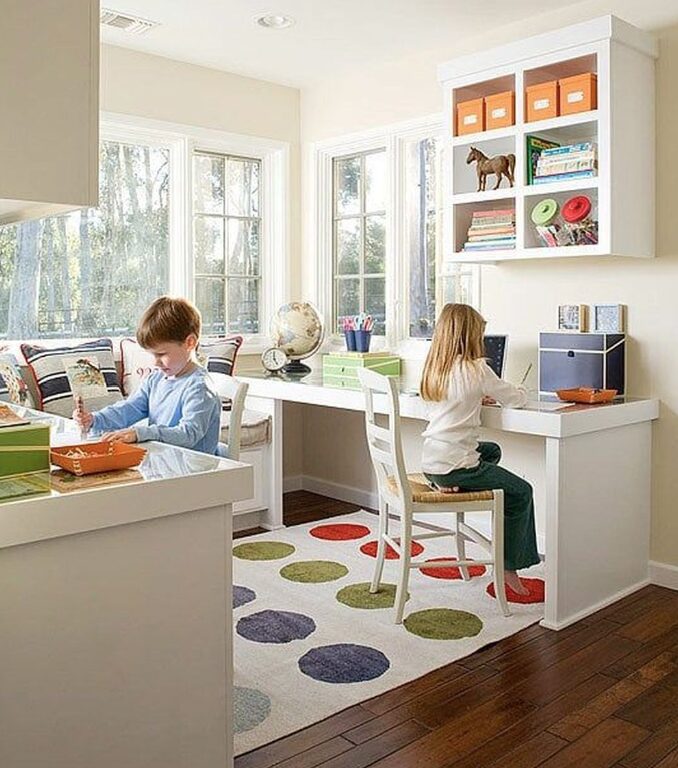Adapting your home to your growing family can be a tall order. When you suddenly need a study area for your kindergartener instead of a nursery, your choices can come down to moving or renovating — both of which are less than ideal.
Moving is one of the most stressful life events you can experience, with nearly half of recent movers saying the moving process brought them to tears. Although renovations may be less stressful, they can be very expensive.
The average homeowner spends nearly $4,000 a year on renovations. Add in the fact that a large majority of homeowners are happy with their home just as it is, and it becomes an even tougher choice.
But there’s a middle path. Converting an existing space into a productive study area for your child can be easy, inexpensive, and effective if you follow a few simple principles.
Establish boundaries
You’ll want the study area to be separate from recreational and living spaces so your child can focus when they’re studying. You can do this using room dividers, bookshelves, or other barriers. You’ll likely need some storage for the study area, too, so look into combination pieces that can function as storage and a desk or shelf.
Personalize the study area
In addition to being a defined, separate space, you want your child to feel they have some ownership over their study area. This will help them feel more comfortable and motivated when it’s time to do their work.
You can do this by letting them collaborate on the study area’s construction. Let them pick out some of the colors, decor, or location. You can also put up wall hangings that reflect their interests, as well as trophies or certificates they’ve earned at school.
Include some greenery
Many studies have found that plants can lower stress and improve concentration, as well as improve the air quality. Put some hanging plants or a few potted plants in your child’s study area to give it a touch of green.
You could also give your child the responsibility of watering and caring for the plant. Like taking care of a pet, nurturing a plant can be a great low-stakes way to teach your child about responsibility and care.
Pick the right color
Color might be the single most important factor in how a room makes you feel. Bright, vivid colors stimulate and arouse, while neutral or tranquil colors can induce calmness or drowsiness.
You’ll want to walk a delicate balance in a child’s study. Make it too stimulating, and they could act out. Make it too calming, and they could become sleepy and unmotivated.
Experts suggest staying away from bright red, which can increase your child’s heart rate, or neutral tones, such as beige or light gray. Opt for a bold blue or green instead. Blue is a solid choice, as it’s been shown to encourage clear thinking and concentration.
If solid color blocks seem a bit boring, consider stripes or geometrically patterned wallpaper to make the space a little more visually interesting.
Use the right lighting
Lighting is extremely important for productivity. The ideal lighting will always be natural light, so it helps if you can locate your child’s study area in a sunny spot with lots of windows.
If this isn’t possible, or if they tend to do their work after sundown, use focused task lighting. Task lighting is simply lighting that has a specific, defined purpose. Think of a desk lamp or the light next to your reading chair.
Task lighting keeps workers on task by spotlighting their attention. Get your child’s desk a small lamp or mount a wall lamp next to their study area. They’ll know that when the light goes on, it’s time to work.
Declutter
Visual clutter detracts from concentration and can cause anxiety, so it’s vital that you keep your child’s study area clean and free of messes. That’s easier said than done, but it can help if you have plenty of storage in the study area so you can quickly whisk stacks of books and papers out of sight when it’s time to get to work.
Make it ergonomically comfortable
You’ll want to help your child maintain good posture because it’s important for their comfort and concentration. Invest in a good, padded desk chair, and make sure it’s at the proper height relative to their desk.
Use a wall or desk calendar
Having a big calendar on the wall or desk in the study area will help your child track their progress and their upcoming assignments. You can also use a large bulletin board or dry erase board for this purpose.
Sibling Sharing: How to Create Harmonious Shared Bedrooms for Kids


